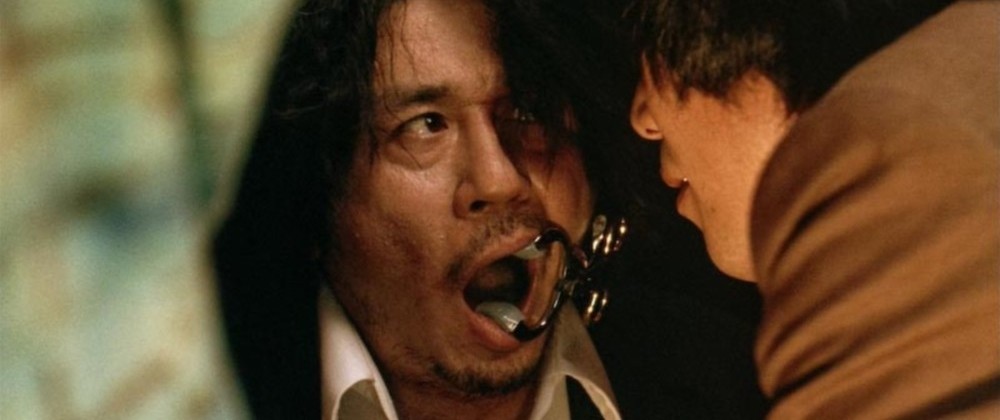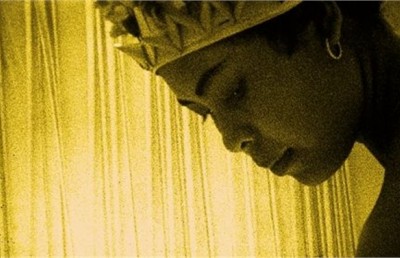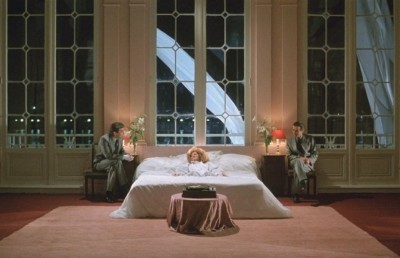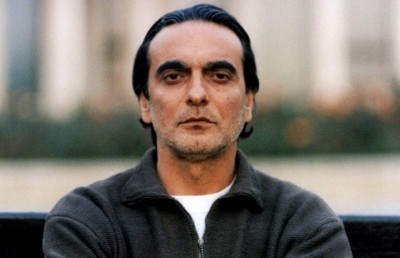Genre: Oldboy and the Suspense Thriller
Park Chan-Wook

The first time I saw Oldboy I was impressed by the ways in which the director had assimilated different genre conventions and had mixed them with a number of European cinematic techniques. My second, third and fourth viewings made me wonder about the particular genre to which Oldboy belonged. Clearly, the suspense Park Chan-Wook had brilliantly managed to create reminded me of the way Hitchcock always succeeded in keeping the spectators on the edge of their seats. On the other hand, the Oedipal subtext that pervades the filmic text is a direct reference to Sophocles’ tragedy Oedipus Rex, first presented in 415 B.C. Was I then dealing with a suspense thriller with tragic overtones? Or is tragedy a necessary ingredient to all suspense thrillers?
Since the 1970s, genre theory served as an alternative to the powerful auteur theory and tried to examine the main Hollywood genres from different angles. However, the suspense thriller did not receive a lot of attention “in part, perhaps, because it has been so associated with the work of one particular director, Alfred Hitchcock…” (Pam Cook & Mieke Bernink, 179), who interestingly enough constitutes the main factor behind Park’s decision to become a director. [1] Therefore, an analysis of Oldboy in the context of genre theory “allows one both to better appreciate the significant elements of the individual film and to examine other viable directions it could have taken, subjects which might not readily be apparent without a broader understanding of the parent genre itself” (Wes D. Gehring, 3), as well as keep “one alive to the cultural changes forever taking place in the world at large” (Wes D. Gehring, 3). It should also be noted that Oldboy is not a Hollywood product, but an Asian film that follows the critically acclaimed wave of South Korean films which, for more than a decade, remain among the award recipients of the world’s most prestigious film festivals. ??Oldboy??’s cultural origins serve as another focal point of this essay, since globalization in the age of transnationalism do not prevent non-American films from reaching a global audience. [2]
Genre Trouble
Film Studies has always been interested in classifying filmic texts and labeling the different ways filmmakers handle their stories. Quite a few books and articles prove that genre theory and criticism are still trying to reach a concrete and uncontestable theoretic basis on which they can categorize earlier and current films. Genre theory of the 1970s tackled the question of genre and theorists talked about film categories based on exclusively subjective criteria. Judith Hess Wright lists the western, the science fiction film, the horror film and the gangster film as “the most popular… products ever to emerge from the machinery of the American film industry” (Judith Hess Wright, 1), whereas Edward Buscombe considers the western as “the most important of the genres” and lists the gangster movie, the musical and the horror film as genres to be inquired into (Edward Buscombe, 35). We have not gotten any closer to a consensus in recent years. For instance, Richard Maltby underlines that “the western, the comedy, the musical, and the war movie are four uncontested categories,” and lists the thriller, the crime or gangster movie, the horror movie and the science fiction film as categories worth analyzing (Richard Maltby). Similarly, Wes D. Gehring lists nineteen different genres, excluding the suspense thriller, the romantic comedy and the epic, while including the clown comedy and the social problem film (Gehring, 3). While theorists keep trying to discern the characteristics of a specific genre in corpora of films, Steve Neale notes that “genres do not consist only of films: they consist also, and equally, of specific systems of expectation and hypothesis that spectators bring with them to the cinema and that interact with films themselves during the course of the viewing process” (Steve Neale, 60). Neale also underscores the historical character of genres by presenting film companies’ catalogues of the 1900s which categorize their films according to their own criteria and concludes that “genres are inherently temporal: hence, their inherent mutability on the one hand and their inherent historicity on the other” (Neale, 62). In other words, Oldboy can belong to the same genre, that of the suspense thriller, alongside Hitchcock’s films but one should not expect it to follow suit, because of, above all else, the forty years that separate them.
The Suspense Thriller
Pam Cook and Mieke Bernink list the detective film, the gangster film and the suspense thriller as “the three principal genres of crime as a whole” [Cook, Bernink, 179), noting at the same time that “these genres and their characteristics often overlap and cross-fertilize in individual cycles and films.” As I have already mentioned, the suspense thriller is one of the least investigated genres, partly because of Hitchcock’s incontestable mastery and the theorists’ seduction by his oeuvre. Charles Derry is one of the few theorists who tried to systematize the genre and shift the focus to films other than Hitchcock’s. Derry defines the suspense thriller as “a crime work which presents a generally murderous antagonism in which the protagonist becomes either an innocent victim or a nonprofessional criminal within a structure that is significantly unmediated by a traditional figure or detection” (Charles Derry, 62). Derry’s broad definition means that films as different as Vertigo (1958) and Fatal Attraction (1987) fall under the same label, and that is why he further recognizes six major sub-types:
1. The thriller of murderous passions… organized around the triangular grouping of husband/wife/lover. The central scene is generally the murder of one member of the triangle by one or both of the other members. The emphasis is clearly on the criminal protagonist… [and]… the criminal motive is generally passion or greed,
2. the political thriller… organized around a plot to assassinate a political figure or a revelation of the essential conspiratorial nature of governments and their crimes against the people. These films generally document and dramatize the acts of assassins, conspirators, or criminal governments, as well as the oppositional acts of victim-societies, countercultures, or martyrs,
3. the thriller of acquired identity… organized around a protagonist’s acquisition of an unaccustomed identity, his or her behavior in coming to terms with the metaphysical and physical consequences of this identity, and the relationship of this acquisition to a murderous plot,
4. the psychosomatic thriller… organized around the psychotic effects of a trauma on a protagonist’s current involvement in a love affair and a crime or intrigue. The protagonist is always a victim –generally of some past trauma and often of real villains who take advantage of his or her masochistic guilt,
5. the thriller of moral confrontation… organized around an overt antithetical confrontation between a character representing good or innocence and a character representing evil. These films often are constructed in terms of elaborate dualities which emphasize the parallels between the victim and the criminal, and
6. the innocent-on-the-run thriller… organized around an innocent victim’s coincidental entry into the midst of global intrigue… the victim often finds himself running from both the villains as well as the police (Derry, 72-272).
Derry’s categories are helpful and perceptive but they are in no way exhaustive. Modern suspense thrillers may defy the above categorization as genres “frequently hybridize and overlap” (Neale, 3), changing and evolving at the same time.
The Case of Oldboy
The first two scenes of Oldboy establish the mood of the mystery which will have to be solved. The first one, which also pays tribute to the French Nouvelle Vague as far as editing style is concerned, presents the inebriated protagonist Oh Dae-Su (Choi Min-Sik) –we are told his name means “getting along with people”– in a cramped police station. We watch the protagonist’s different reactions to his arrest as he sits still, shouts, wears the angel wings he bought for his daughter as a birthday present, gets hit by policemen, takes off his shirt, and falls on the floor. Numerous jump cuts break the time continuity and one could argue they serve as the subjective recounting of events through Oh Dae-Su’s distorted perception caused by alcohol consumption. When the hero leaves the station (we never learn why he was there in the first place), he is mysteriously abducted and the next scene shows his face near a slot on the bottom part of the floor and a tray handed by someone whose face is not revealed since the camera is positioned at the eye level of the hero. Oh Dae-Su is imprisoned in a room with a bed, a desk, a television, and a bathroom cubicle. In voice-over he informs us that he spent fifteen years in confinement, while the accompanying images present scenes from his long period of captivity. We learn that Oh Dae-Su was drugged every night, had his hair cut, and his room cleaned while he was sedated. His loneliness was only ever interrupted by the television, which is “both a clock and a calendar. It’s your school, your home, your church, your friend… and your lover.” The voice-over is accompanied by historical moments that appear on his television screen condensing time and reducing a fifteen-year history into selected images that last a few seconds.
Aside from events with global impact, such as Princess Diana’s death in 1997, the terrorist attack on the Trade World Center in 2001, and the World Cup in South Korea and Japan in 2002, the images present Korea’s difficult path towards democracy. Oldboy was released in 2003, thus Oh Dae-Su was captured in 1987, an important date in South Korea’s history, as it was the year of “the first direct election in 16 years… one in which the people of Korea had regained their right to choose their own president” (Lee Manwoo, xi). Park’s choice of reproducing images from his country’s recent history, from President Roh’s conviction for bribery in 1996, the financial problems of 1998 and 1999, to Kim Dae Jung’s effort to implement new policies in the new century, and his visit to North Korea’s president, Kim Jong Il, states the fragile balance of a whole society and explains in part, the rise of the suspense thriller and crime films that have emerged in the 1990s in South Korea. [3] Uncertainty, anxiety and fear consumed the country’s citizens, and film spectators were more than willing to enjoy suspense and even extreme thrills through the voyeuristic mechanisms of film [4], just as postwar American citizens cultivated an affinity towards the film noir in the late 1940s.
After fifteen years, Oh Dae-Su is released, without an explanation. He is provided with a cell phone and money, and left to his own devices. The plot starts after the first sixteen minutes of the film, which served as a descriptive prologue to the status and the gradual transformation of the hero, from the already dysfunctional but weirdly funny family man of the first scene, to the vengeance machine he becomes for the rest of the film. Oh Dae-Su is determined to find the person who deprived him of fifteen years of his life. He finds a valuable ally and lover in the form of a young sushi chef, Mi-do (Gang Hye-Jung) and together they follow clues in order to unravel the mystery. The plot follows the traditional narrative of the suspense thriller which sees a victim –in this case Oh Dae-Su– tortured both psychologically and physically by an unknown person. However, in contrast to the always refined, sophisticated and in control Hitchcockian heroes, Oh Dae-Su seems to have lost a great deal of his humanity during his imprisonment, turning him into a monster, an insensitive person consumed by rage and sentiments of hatred and cruelty. Little by little, the pieces of the puzzle fall into place, and the spectator meets Oh Dae-Su’s tormentor, Lee Woo-Jin (Yoo Ji-Tae). Lee Woo-Jin is a young millionaire who had an incestuous relationship with his sister in high-school. Oh Dae-Su, who attended the same school, had witnessed the siblings touching and had started a rumor about Lee Soo-ah being pregnant with her brother’s child, which had unpredictable consequences since the young girl could not stand the shame and committed suicide to avoid public humiliation, leaving her brother alone to face the music and deal with her loss.
Lee Woo-Jin then constructed a devious plan to get his revenge on the person who he believed had destroyed his life. Patiently yet methodically, he waited for the right moment to strip Oh Dae-Su of everything and everyone he ever cared for. Woo-Jin murdered his wife, his best friend, and raised his young daughter from the age of three in order to complete his diabolical scheme: to make Oh Dae-Su experience the same criminal feeling that he did, by making the punishment fit the crime. Mi-do is not just a young woman who happened to fall in love with an older man; she is Oh Dae-Su’s daughter. The moment Oh Dae-Su’s realizes that he had a sexual relationship with his daughter, he assumes the paternal role and the first thing he asks is whether his daughter is aware of his true identity. Even though he was accused by Lee Woo-Jin of never protecting the women in his life, he now begs for forgiveness as he realizes he still has a chance to make amends. In Sophocles’ Oedipus Rex, when Oedipus learns that he had unknowingly killed his father, Laius, and had then married his mother Jocasta, fulfilling an ancient prophecy, he uses his wife’s/mother’s golden pins to stab out his eyes. Similarly, Oh Dae-Su falls on his legs, takes a pair of scissors and cuts off his tongue, confirming Lee Woo-Jin’s words:
LEE WOO-JIN: “Your tongue got my sister pregnant! It wasn’t Lee Woo Jin’s dick; it was Oh Dae-Su tongue!”
After the revelation of the mystery and his mission complete, Lee Woo-Jin commits suicide which, along with Oh Dae-Su’s symbolic mutilation, brings catharsis to the story. However, the end credits do not make their anticipated appearance, as Park opts for a more ambiguous ending. In the last scene, Oh Dae-Su is in an unidentified place, in the snowy mountains, and with the help of an expert in hypnosis tries to erase the unbearable memories of the incest. The healer asks him to return mentally to Lee Woo-Jin’s apartment and to split up into two different people when he hears the sound of a bell she is holding. Indeed, the spectators now see two different Oh Dae-Sus: the one who does not remember, and the monster who holds the secret and dies pacing. In the very last scene back in the mountain, Mi-do finds her father on the snow, and hugs him, saying: “I love you Oh Dae-Su.” The spectators know that Mi-do is not aware of the secret and her presence there can be easily explained by the fact that she took care of Oh Dae-Su even when he was a stranger. However, Oh Dae-Su is once again unaware of the young woman’s true identity. Does his smile and tears signify a sexual reunion? Or, does his expression symbolize a deeper understanding of the true bond that unites them? The question remains unanswered and ??Oldboy??’s open ending can be interpreted according to each spectator’s beliefs, background and desires.
Oldboy is a modern suspense thriller with all the traditional narrative “ingredients,” since the plot revolves around a victim in search for the truth. Yet, Oh Dae-Su is not innocent victim. He is not the gentle but curious L. B. Jeffries in Rear Window (1954), nor the honest Dr. Richard Kimble in the Fugitive (1993). He is a man who drinks to excess, talks more than he should and does not seem to care enough for his family. There is a split screen in the confrontation scene which joins Woo-Jin’s half face with Oh Dae-Su’s other half, denoting that the victim and the victimizer share more that we would like to know. However, I do not want to imply that Oh Dae-Su deserves his punishment. On the contrary, his flaws merely demonstrate that unlike most Hollywood thrillers, which prefer their heroes to be impeccable human beings, Asian and European productions approach the genre with increased naturalism (as far as characterization is concerned), and accept a flawed “hero” with whom the audience can identify more easily, since imperfections follow us all, even film heroes.
What Park achieved with his brilliant use of Hollywood suspense techniques (a narrative that works through delay, and camera movement that intensifies audience participation) goes beyond the simple instillation of fear into the audience. Oldboy constitutes a modern tragedy, a psychological thriller which is loyal to most genre conventions and at the same time broadens genre boundaries by incorporating new narrative elements, such as the open ending and the dysfunctional hero in order to underline the turbulent social circumstances in which the film itself is inscribed. Finally, Oldboy confirms that the genre, apart from being “a multi-dimensional phenomenon” is also a multi-national phenomenon, produced, shared and understood in every part of the world, even if a large part of the global audience will have to read the obligatory subtitles.
Filmography
Oldboy (2003), Chan-Wook Park, director
Production Companies: Egg Films, Show East
Screenplay: Jo-yun Hwang, Chun-hyeong Lim, Joon-hyung Lim, Chan-wook Park
Cast: Min-sik Choi (Dae-su Oh), Ji-tae Yu (Woo-jin Lee), Hye-jeong Kang (Mi-do), Dae-han Ji (No Joo-hwan), Dal-su Oh (Park Cheol-woong), Byeong-ok Kim (Mr. Han), Seung-Shin Lee (Yoo Hyung-ja), Jin-seo Yun (Lee Soo-ah), Dae-yeon Lee (Beggar).
Running time: 120 min.
Endnotes
1 In a 2004 interview, Park explains how he decided to become a director: “Originally, I intended to become an art critic… Then one day, I saw Hitchcock’s Vertigo. During the movie, I found myself screaming in my head, ‘If I don’t at least try to become a movie director, I will seriously regret it when I’m lying in my deathbed!’… It is clear that Hitchcock’s movie had a great impact on me at the beginning. Now, however, the influences that keep spurring me on are people like Sophocles, Shakespeare, Kafka, Dostoevsky, Balzac, Zola, Stendhal, Austin, Philip K. Dick, Zelazny and Vonnegut. “
2 In his examination of the neo-noir or global noir “from the point of view of transnational filmmaking, cross-cultural influences, and the idea of global culture”, David Desser states that crime films produced in different countries present interesting similarities in terms of style, thematic lines, and character portrayal. David Desser, ‘Global Noir: Genre Film in the Age of Transnationalism’, Film Genre Reader, ed. Barry Keith Grant (USA: University of Texas Press, 2003), p. 516.
3 Charles K. Armstrong, notes in Korean Society: Civil Society, Democracy, and the State, (London: Routledge, 2002), pp. 1-2 that “the emergence of civil society in South Korea can be seen as part of a global surge of democratization from about the mid-1980s to the mid-1990s, sometimes called the “Third Wave” of democracy, a surge that toppled authoritarian regimes in areas as far-flung as Eastern Europe, Latin America, and South Africa… Throughout the 1990s, South Korea witnessed the growth of intermediate, voluntary associations which influence the political process but are not of it: citizens’ groups, environmental movements, religious organizations, new kinds of student, worker, and farmer organizations, the movement for local political autonomy – in short, the general emergence of new and diverse forms of association in a revitalized “public sphere”.”
4 Some of South Korea’s suspense thrillers of the same period include Shiri (1999, dir. Kang Je-Gyu), The Spy (1999, dir. Jang Jin), Yellow Hair (1999, dir. Kim Yu-Min), Sorum (2001, dir. Yoon Jong-Chan), Sympathy for Mr. Vengeance (2002, dir. Park Chan-Wook), Lady Vengeance (2005, Park Chan-Wook).
Bibliography of Works Cited
Armstrong, Charles K. Korean Society: Civil Society, Democracy, and the State, (London: Routledge, 2002).
Buscombe, Edward. “The Idea of Genre in the American Cinema”, Screen 11, no. 2 (March-April 1970), p. 35.
Cook, Pam & Mieke Bernink, The Cinema Book, (UK: BFI, 2005).
Derry, Charles. The Suspense Thriller, Films in the Shadow of Alfred Hitchcock, (Jefferson: McFarland Press, 1988).
Desser, David. ‘Global Noir: Genre Film in the Age of Transnationalism’, Film Genre Reader, ed. Barry Keith Grant (USA: University of Texas Press, 2003).
Gehring, Wes D. Handbook of American Film Genres, (New York: Greenwood Press, 1988).
Lee Manwoo, The Odyssey of Korean Democracy: Korean Politics, 1987-1990, (New York: Praeger, 1990).
Maltby, Richard. Hollywood Cinema, (Oxford: Blackwell, 1995).
Neale, Steve. ‘Questions of Genre’, Screen 31, no. 1 (Spring 1990), p. 60.
Neale, Steve. Genre and Hollywood, (London: Routledge, 2000).
Wright, Judith Hess. “Genre Films and the Status Quo,”Jump Cut, no 1 (May-June 1974), p. 1.














